Feed the Beast Machine to Clear Large Amounts of Land
Carter Newell owns and operates one of the most productive mussel farms in the state of Maine. One frigid spring morning I joined him and his two-person crew on a short boat ride to the barge he calls Mumbles, a 60-by-24-foot vessel anchored that day in a quiet cove in the brackish Damariscotta River. Named for the Welsh seaside town where Newell once did research, Mumbles was tethered to a steel-framed raft hung with hundreds of 45-foot ropes, each thick with thousands of mussels in various stages of development.
I shivered in the piercing wind as a crew member stepped from Mumbles onto the shifting raft to identify mussel ropes ready for harvest. Newell remained on the barge to helm a 16-foot crane that hauled up the designated ropes, each heavy with a Christmas tree–shaped aggregation of roughly 3,000 mussels. An outsized brush then swept the bivalves off the ropes and into an enormous stainless steel bucket. Another machine funneled them into a heavy polyethylene bag the size of a baby elephant, from which they were poured onto a conveyor-belt apparatus to be scrubbed, sorted and bagged. Newell designed this ungainly Willy Wonka–esque apparatus over decades in a costly process of trial and error that faced—and ultimately overcame—several challenges, including protecting the mussels from turbulent seas and voracious eider ducks.
As he oversaw the morning harvest, Newell, who has a Ph.D. in marine biology, talked some science—the dynamics of phytoplankton, why nitrate chemical concentrations increase in the winter, how chlorophyll levels for the entire coast of Maine can be mapped with just three satellite images. Mostly, though, he talked about mussels: their life cycle, their geographic distribution, how to prepare them (don't spare the garlic) and—critically—how best to farm them without going broke. "Fish farming is no way to make a quick buck," he told me.
The truth is that soon fish farming may be the only way for Maine's struggling seafood workers to make any bucks at all. Thanks to overfishing, parasites and rising ocean temperatures, among other threats, nearly all of Maine's commercial fisheries are in free fall. Maine cod is crashing, as are local shrimp. The wild mussel catch declined from 25 million pounds to a mere nine million over the past two decades. And lobsters, by far the state's most profitable catch, are scuttling north to cooler Canadian waters. None of this bodes well for the state's once robust seafaring economy: the average age of a Maine commercial fisher hovers above 50, suggesting that many young people have lost faith in the work.
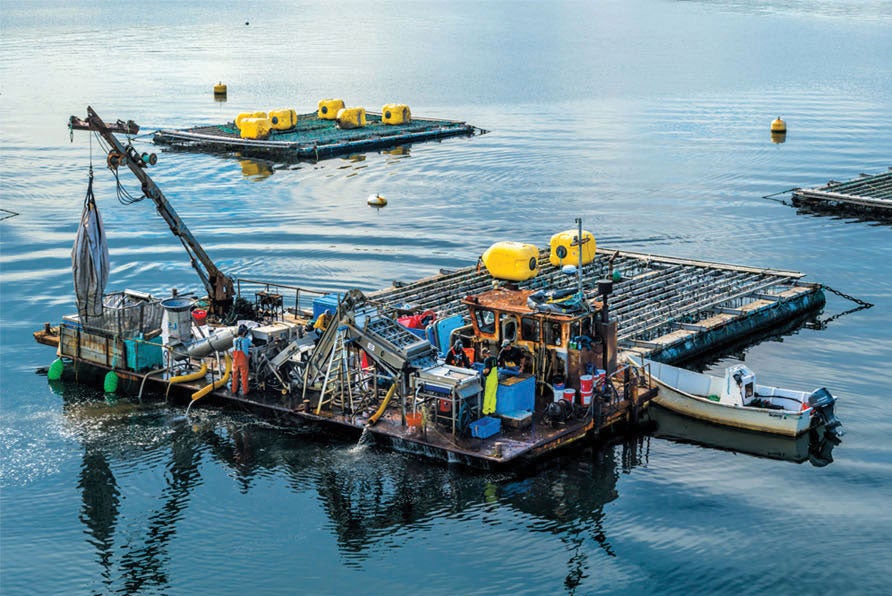
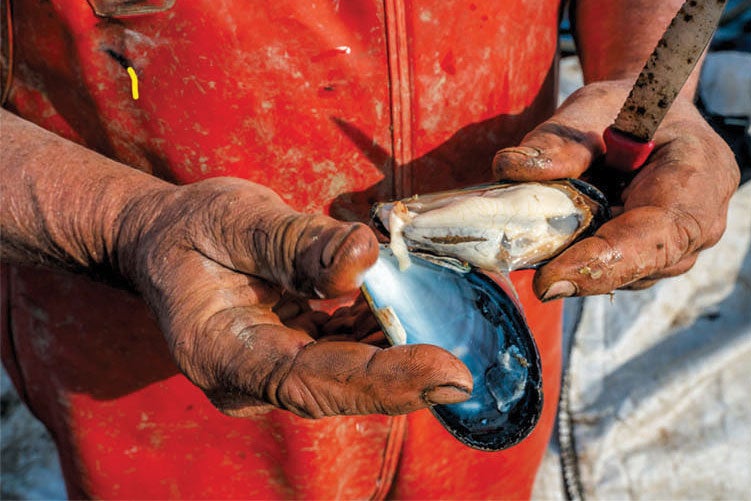
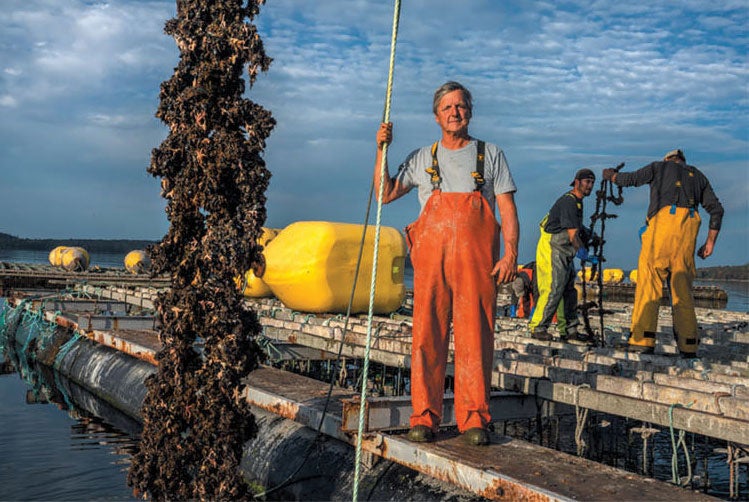
As one wild fishery after another falters, the future of Maine—and, some say, the future of seafood—may lie in aquaculture, the cultivation of aquatic plants and animals. Historically, intensive fish farms have been linked to a lot of bad things: declines in biodiversity, habitat loss, the overuse of antibiotics, and animal welfare abuses, especially in Asia and Latin America. And in recent years fish die-offs and other problems have plagued North American sites. But Newell represents a new breed of scientist with innovative approaches to growing fish that are both economically and environmentally sustainable. His kludgy mussel-growing apparatus generates three times as much seafood as traditional mussel farms. And because free-floating mussel larvae seed the ropes naturally and eat whatever phytoplankton drifts their way, Newell's farms require no human-generated feed or energy, a boon for the environment as well as for his bottom line.
A far more controversial experiment in Maine involves cultivating finfish such as salmon and yellowtail either in immense net pens in the ocean or, more recently, in land-based operations where thousands of metric tons of fish circle gigantic tanks like felons pacing around a prison yard. Fish in these recirculating aquaculture systems (RAS) consume a steady diet of scientifically designed feed and, if need be, infection-fighting drugs. The current they swim against is artificially generated, as is the LED light that bathes them up to 24 hours a day to hasten their growth. It is a surreal scenario, but proponents claim RAS are well positioned to bolster Maine's economy while serving the nation's growing demand. "The U.S. runs an enormous seafood deficit," says microbiologist Deborah Bouchard, director of Maine's Aquaculture Research Network, noting the country relies heavily on fish imported from other nations. "Maine is building on the opportunity to fill the gap."
Oceanographer David Townsend, director of the School of Marine Sciences at the University of Maine, says the state has two important attributes for fish cultivation: cold, nutrient-rich water and extremely vigorous tides that distribute those nutrients throughout the water column. "Our coastal waters are very productive," he says.
But the farming of large, carnivorous fish makes some scientists uneasy. Recirculating tanks require huge amounts of energy to move and filter millions of gallons of water daily, and that water still holds waste that can pollute nearby rivers and estuaries. Also, there's a matter of the fish and their welfare. "Farming finfish on an industrial scale is like farming livestock on land on an industrial scale," says economist Rosamond L. Naylor, who directs the Center on Food Security and the Environment at Stanford University. "There are ways to minimize risks, but they are costly, and not everyone is taking the steps they should be taking."
The question of whether industrial aquaculture will enrich Maine's economy without damaging its fragile ecosystems haunts scientists, politicians and residents. The Gulf of Maine is the least alkaline body of water on the Atlantic coast between Mexico and Canada, and its delicate chemistry is particularly vulnerable to disruptions both natural and human caused. Whatever their outcomes, Maine's experiments will set an important precedent for seafood production around the globe.
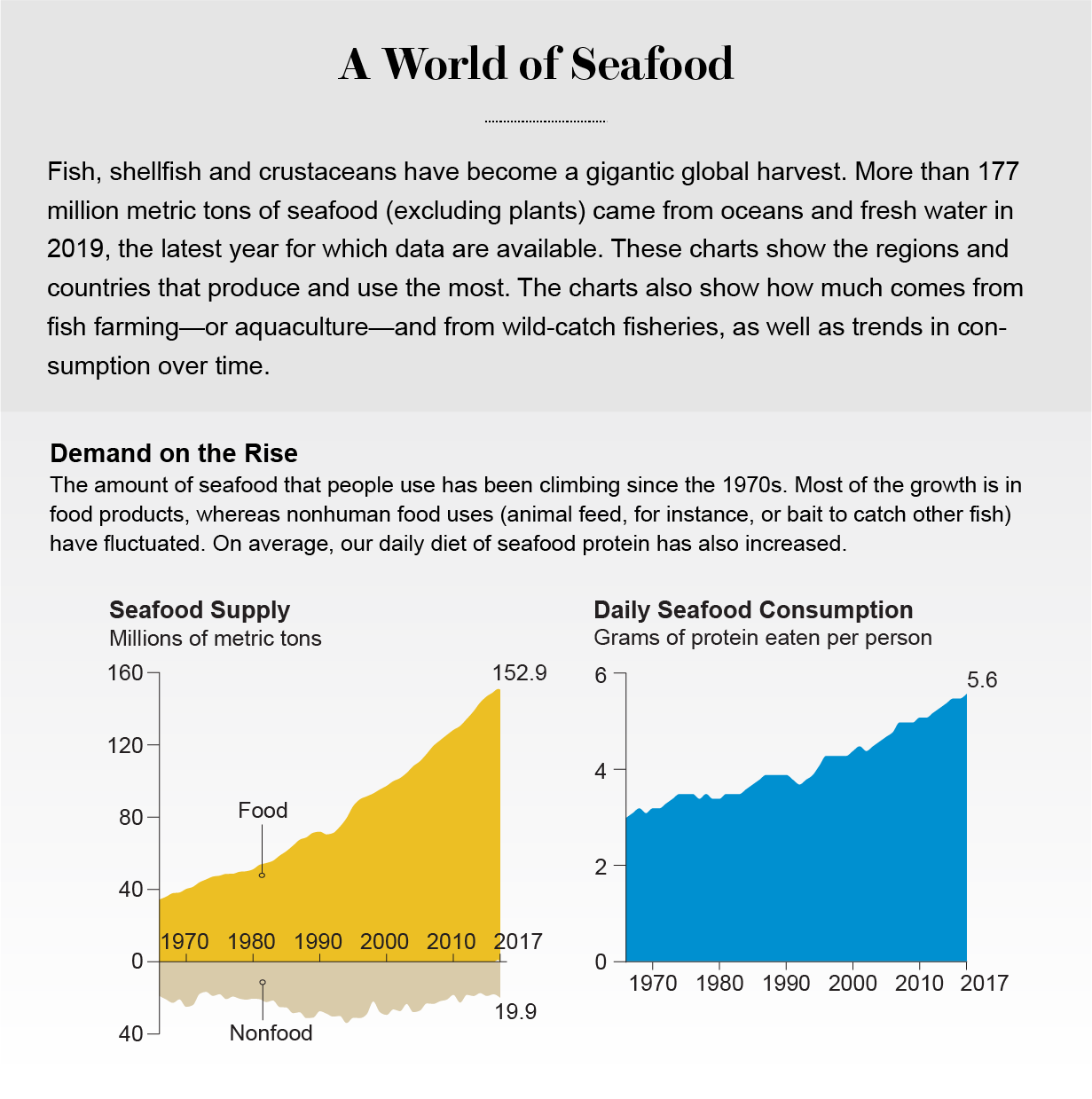
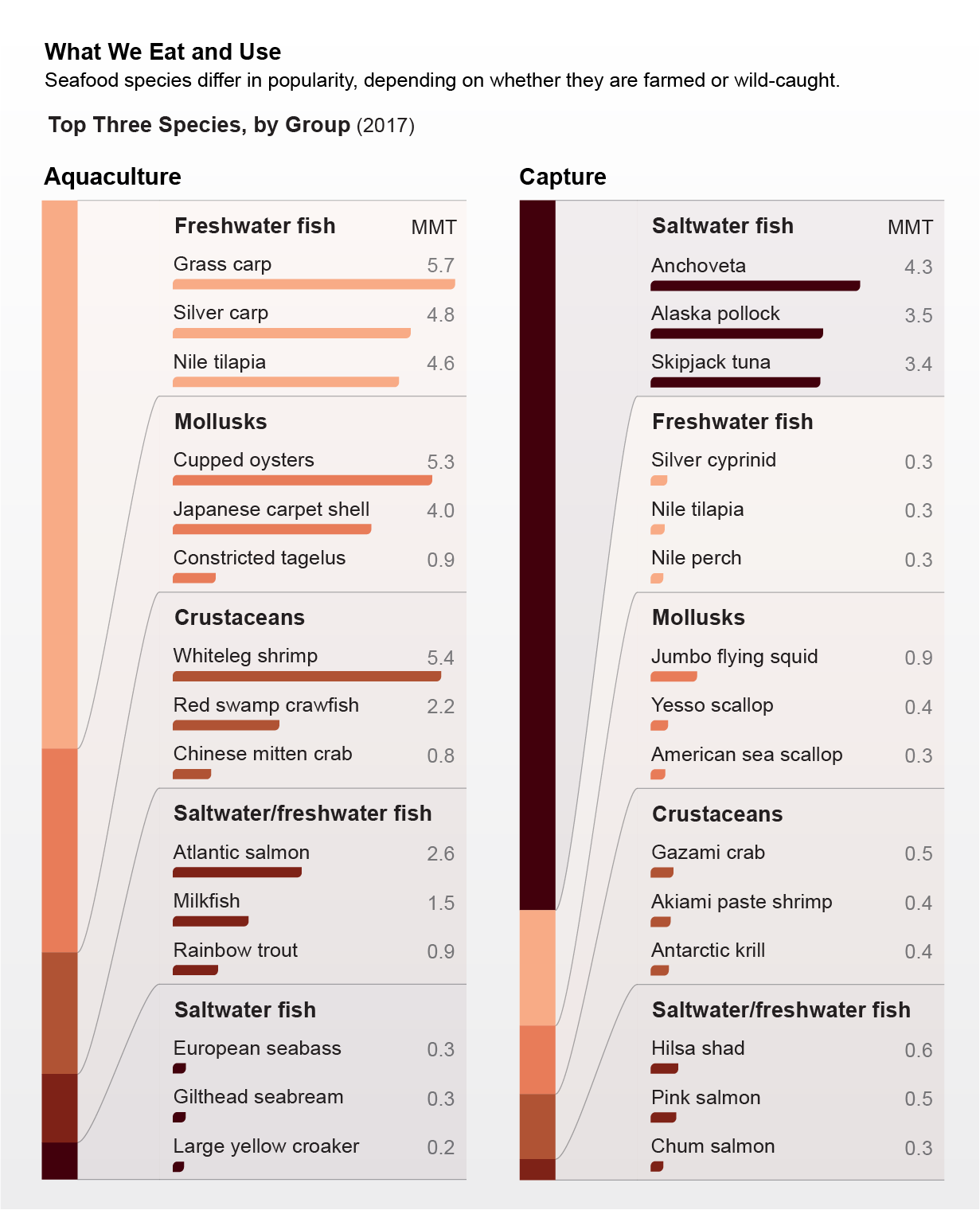
Scientists agree that the food supply must increase substantially to feed the world's growing population and that cultivated fish, shellfish and algae will play a major role in that expansion. Aquaculture is already the world's fastest-growing sector of food production, churning out more than half of all fisheries products, and seafood is the most traded commodity on the planet. But although Americans eat a lot of seafood, relatively little is homegrown: an estimated 65 to 85 percent of fish bought for consumption in the U.S. is imported, most of it from China. The U.S. does not export much farmed fish, either, because it grows so little of it. According to the most recent data, from 2019, the U.S. produced 490,000 tons of farmed fish, barely a rounding error compared with the roughly 49 million tons produced by China.
Maine's Atlantic salmon could help the U.S. compete. Often called the "king of fish," salmon are sleek, shiny and beautiful. They are also an extremely popular menu item, ranking second only to shrimp as America's favorite seafood. The cold-water fish were once plentiful in Maine, but dams, overfishing, parasites and pollution all led to the closing of the state's wild Atlantic salmon fishery in 1948, and today it is illegal to catch or sell them. Today more than 95 percent of Atlantic salmon sold in the U.S. is foreign-grown, most in net pens anchored just below the surface in coastal waters.
Open fish pens have been used in Norway since the 1960s and are still in use in Canada and Chile, but environmental concerns have led to bans in most U.S. coastal states. A ban in Washington, which goes into effect in 2025, will leave Maine as the only state that still sanctions their use. Despite rigorous regulations, every year net-pen operations are cited for environmental and labor-related malfeasance, infestation by sea lice and other parasites, and infectious disease. Scientists say an equally vexing challenge is posed by renegade fish that escape the pens and mate with wild salmon to produce offspring that are genetically ill-equipped to survive. This last threat is especially concerning in Maine, home of the nation's last remaining wild Atlantic salmon population.
Feed is another major problem. Salmon farmers sometimes inadvertently overfeed their stock, and the uneaten feed promotes the growth of algal blooms that deoxygenate the water as they decompose. This can lead to "dead zones," wide swaths of ocean that can no longer sustain life. Another often cited concern is that until quite recently, a high proportion of fish feed consisted of small wild-caught "forage fish" such as anchovies, herring and sardines, all rich in the long-chain omega-3 fatty acids necessary for the growth of larger fish. From 1950 to 2010 roughly 27 percent of all wild-caught fish was used in fish meal. Many observers saw this as a terrible waste: they argued that feeding edible fish to edible fish is unsustainable and ultimately makes little economic or ecological sense.
Food scientists have sought alternatives, but it has not been easy. Carnivorous fish have difficulty digesting carbohydrates, so researchers tried various combinations of plant fats and proteins, including those found in soybeans. "It's like Impossible Burger for fish," Townsend says. Unfortunately, like humans, not all salmon can tolerate soy, which in large quantities can damage their gut and immune system.
Experimental fish feeds aim to solve this problem and address yet another concern: that waste from fish pens will pollute natural waterways. New "low-polluting" feeds contain far less nitrogen and phosphorus and provide nutrients in a form that is easily digested and absorbed to minimize the amount of these elements excreted by fish. Emerging feeds include algae oil, yeast protein and black soldier fly larvae, commonly known as maggots. Scientists are also designing proteins with amino acid compositions similar to those in feed made of fish but created from sawdust and other forest residue plentiful in the sylvan state of Maine. Whether algae, maggots or reconstituted sawdust will ultimately replace fish in the aquaculture food chain is unclear, but scientists agree that these experimental feeds show substantial promise. Still, growing fish in pens in the open sea poses risks that some believe outweigh the benefit.
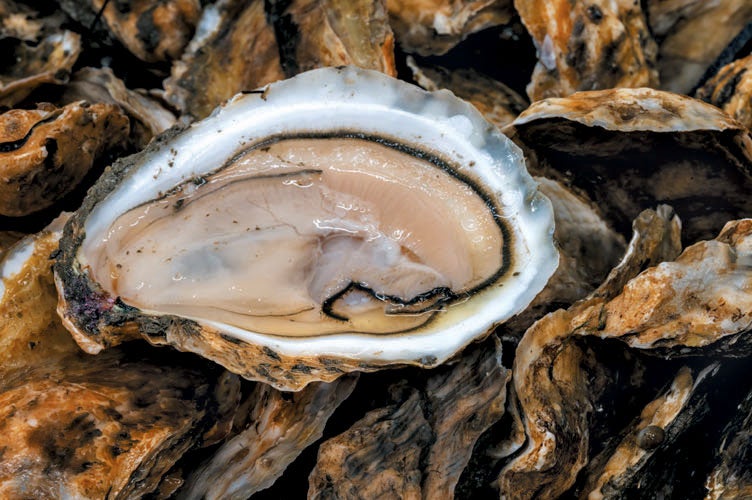

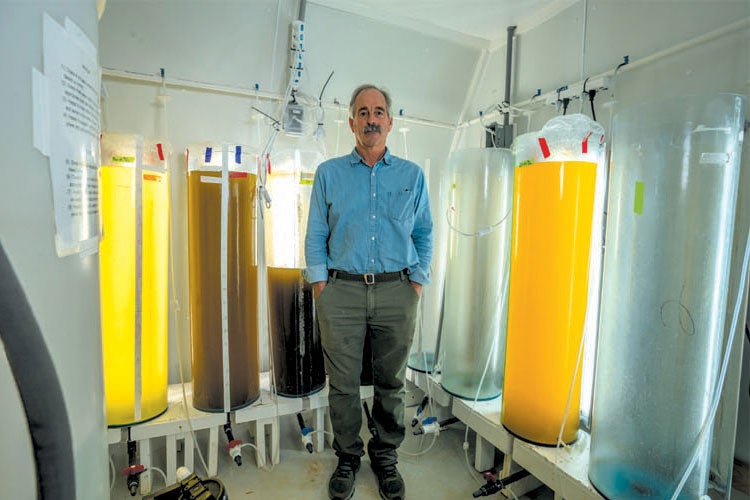
Giant RAS tanks are meant to minimize several of the environmental threats posed by net pens. The approach dates back to the 1950s, but recently scientists and engineers have supercharged the technology into a mind-bogglingly efficient protein-generation machine capable of growing more fish in less time and space than is possible in nature. In contrast to offshore net pens, land-based RAS are designed to maintain tight control over water quality, temperature, circulation and other environmental variables. Bacteria convert ammonia excreted by the fish into typically harmless nitrate; gas-exchange systems add oxygen and remove dissolved carbon dioxide; and wastewater is microfiltered and zapped with ultraviolet light to remove phosphorus, lingering bacteria and viruses. Some of the newest systems feature machine-vision sensors and artificial intelligence to optimize feeding by monitoring fish biomass and behavior in real time.
Several multinational RAS companies are currently vying for a stake in Maine. Notable among these is Nordic Aquafarms, a Norwegian firm that has proposed a major tank facility in the small coastal city of Belfast. Nordic's $500-million plan to generate nearly 73 million pounds a year of Atlantic salmon would make it the second-largest RAS salmon farm in the world. The largest is an operation run by Atlantic Sapphire, another Norwegian-owned firm based in the unlikely location of Homestead, Fla. That facility has suffered a series of crises, including a massive "mortality event"—elevated gas levels that wiped out 500 tons of salmon. In the first half of 2021, the company reported losses of more than $50 million and faced accusations of criminal animal cruelty.
Nordic Aquafarms founder and president Erik Heim insists that his company will avoid these problems, but researchers are cautious. Jon Lewis worked for 23 years as a scientist and diver, and he recently retired as director of the Division of Aquaculture in Maine's Department of Marine Resources. "Land-based systems have real advantages in that they don't rely on Mother Nature for water treatment," he says. But even if the filtration systems remove most of the discharged waste, he adds, some still flows to the bay. "Given the scale of these systems, that's significant."
At the Belfast facility, salmon eggs will be incubated in specially designed hatching cabinets, and the emerging baby fish, known as fry, will spend the first few weeks of their lives eating their yolk sacs before entering a quarantine tank. The young fish will then move to a series of tanks that simulate the natural life cycle of salmon—swimming from fresh water to increasingly salty water over a period of 18 to 20 months, when they reach market size. Heim says the system currently circulates 5,500 gallons of water a minute: 4,700 gallons of salt water sucked from the Gulf of Maine and 800 gallons of fresh water pumped from groundwater wells and aquifers.* Filtered waste will be converted into animal feed or fertilizer—in theory enough to fertilize about seven and a half pounds of vegetables per pound of fish produced.
Unfortunately, pumping and filtering all that water requires a lot of power, as does heating the water in winter and cooling it in summer—all of which can contribute to the climate crisis. "We really don't have data on the energy use in these systems compared to other approaches, but it's clearly very high," Lewis says. A review sponsored by Maine's Department of Environmental Protection concluded that the plant will release as much as 759,000 metric tons of carbon dioxide equivalents into the atmosphere every year, roughly equal to the annual CO2 contributions of 47,000 Americans.
There are also fundamental objections to raising free-ranging creatures such as salmon in crowded captivity. The animals we lump together and call "fish" represent a staggeringly diverse array of species, some of which have incredibly complex social structures and navigation abilities, says Becca Franks of New York University, a psychologist who researches animal behavior and welfare. Atlantic salmon are a case in point: they migrate 2,000 nautical miles to and from their spawning grounds guided only by Earth's magnetic fields and an acute sense of smell. "Farming salmon is the moral equivalent to farming hawks," Franks says. "We need to think about the stress and suffering of these animals ... about how they live their natural lives."
Not all sea animals are the aquatic equivalent of a hawk, however, and some take well to domestication. Sandra Shumway, a marine scientist at the University of Connecticut, is an internationally recognized expert on the cultivation of sea life. "I do think it's very important that we grow more micronutrients and protein for human consumption," she says. "But let's think about bivalves."
Bivalves require little space, and some—such as mussels and oysters—barely demonstrate an inclination to move. "They're more like potatoes or avocados than salmon," Franks says. Even better, unlike potatoes and avocados, bivalves can be grown without human-supplied fertilizer, water or food. Farmed oysters typically start as larvae, which quickly mature into tiny "seed" oysters that attach to a hard surface such as shell or limestone and are then transferred into estuarine bodies of brackish water to feed on whatever nutrients naturally float their way. These "filter feeders" siphon water through their gills to extract phytoplankton, of which Maine harbors at least 300 species. Waterways inhabited by bivalves are often so clear that sunlight penetrates far below the surface, further promoting the growth of phytoplankton. Some scientists and farmers are hoping to build on this "virtuous cycle" by deliberately planting kelp and other seaweed in close proximity to bivalves. Under this arrangement, the animal waste would provide nutrients for the plants, and the plants would remove CO2 and generate oxygen for the animals.
Maine's coastline, crenellated with deep estuaries and bays fed by rivers mixing with cold ocean water that pumps nutrients up from below, may seem like a bivalve paradise. But frigid water is a double-edged sword. Oceans store up to 30 percent of the world's output of CO2, and cold water, in which the gas is most soluble, absorbs far more than its share, making it more acidic. The rising acidity of Maine's rivers and estuaries threatens to erode the shells of soft-bodied invertebrates such as bivalves left to their own devices.
Bill Mook has had painful experience with this problem. Founding owner of Mook Sea Farm and Hatchery on Maine's Damariscotta River, one of the two largest oyster producers in the state, he grows both mature and seed oysters. A few years ago he noticed that his oyster larvae were not developing normally, a problem he traced to increased acidity of the river water flowing through his hatchery. The water also softened the shells of mature oysters, especially during hard rains, when the river ran highest. Mook found a way to buffer seawater to protect the oysters growing in the indoor hatchery, a remarkable innovation that—though highly labor-intensive—may well catch on with other Maine bivalve farmers if acid levels continue to rise.
Housed in a pair of Quonset huts, Mook's oyster-growing facility looks more like a laboratory than a farm. In the spring of 2021 Meredith White, director of research and development at the company, ushered me into the hatchery, a moist, cavernous space that reeked of the sea. White first met Mook while she was a research scientist at Bigelow Laboratory for Ocean Sciences in East Boothbay, Maine, and her knowledge of bivalves is exhaustive. Mook's oysters, she says, are bred for certain traits—size, shape, disease resistance—in shellfish labs in Virginia and New Jersey and shipped to Mook's as brood stock. "Some are male, some are female, but you can't tell which without opening them, and that would kill them," she says.
Workers need to wait for the oysters to declare their own sex: both females and males clap their shells before a spawning session, during which females release a cloud of as many as 20 million eggs and males emit a stream of sperm. Technicians carefully combine the eggs and sperm in small white bowls to begin a process of in vitro fertilization. The resulting embryos are transferred to tanks holding 3,000 to 6,000 liters of water, which is gradually warmed to optimize growth. "We check them under a microscope every day," White says. "We can see the cells divide, and in 24 hours, they have a shell."
In about two weeks the oysters form a pigmented eyespot (interestingly, mature oysters have eyes all over their bodies), a sign that they are approaching the pediveliger stage, when they will sprout the bivalve equivalent of a foot. White pulled out trays of ground oyster shell on which tiny oysters "set" this foot, glomming on to the hard surface with a kind of natural glue, much as they would in the wild. "We sell 140 million seed oysters a year," she says. Those oysters, sold to oyster farmers around the state, will eventually grow into mature oysters that go for about $15 a dozen in local markets or $25 a dozen at restaurants.
In Maine the oyster-growing season lasts only five months, from April to October. But Mook's success derives in part from his ability to extend this period by growing them indoors in the colder months, beginning in January. Like cats and dogs and chickens, indoor oysters need to be fed. Mook has developed proprietary growth and processing techniques for algae, and the details are a company secret. He notes the minute organisms are heterotrophic, meaning they can extract energy from sugar, and they do not require light, which helps to reduce his electricity costs. This money-saving innovation was a game changer.
"Bill's system is ingenious and entirely scalable," Lewis says. It is the first time food has been created specifically for bivalves with this technology, he says, and "it could revolutionize the industry." It also demands a very exacting manufacturing process. "We feed the algae glucose and grow it in a clean room under negative pressure to avoid contamination," Mook tells me as I watched a technician scrub and suit up like a surgeon in paper cap and booties before entering the pristine space. "We harvest the cells every seven days, spin them down in a special centrifuge to preserve their structure, squeeze out the water and freeze the paste in one-kilogram blocks." Mook opened a freezer and pulled out a Ziploc plastic bag of icy green slime. "It took us 10 years to develop this," he said, then hustled us off to the "growing room" filled with lab beakers, each containing a different variety of algae in shades of green, yellow and orange.
Mook says oysters are more finicky than mussels, another creature he has tinkered with. "Growing oysters versus mussels is like growing orchids versus tulips," he tells me. "Mussels bring less money per pound, but once you've got the infrastructure in place, they are a lot cheaper to grow because, unlike oysters, the seed is wild and free." Townsend agrees. "Mussels grow at very high density, they contain a lot of protein, and they are a good source of omega-3 fatty acids and other nutrients," he says. "If we could get the whole world to eat more mussels, we'd be in much better shape."
Newell has spent decades trying to make that dream a reality. Decades ago, when he got his start, mussel rafts were not a thing in Maine. Rather farmed mussels were grown on a single long line threaded through buoys bobbing on the surface of open water. In many places, this method is cheap, efficient and effective. But not in Maine. The state is swimming with sea ducks, including six-pound eiders that eat their weight in mussels every day. The duck problem foiled Maine's would-be mussel farmers for decades, until Newell and a handful of other enthusiasts learned about a Spanish method of dropping lines into the sea from an anchored raft, which they figured could be duck-proofed with nets. They built 35 rafts and anchored them in various waterways throughout the state. And "we installed nets around the raft—60 feet deep," Newell says.
That solved the duck problem, but they soon faced another. The rafts were built for calmer waters, but on Maine's stormy coast, winds raging at 60 or 70 knots dislodged mussels and destroyed the rafts.
With the help of government grants, Newell designed and patented a submersible raft that minimized perturbations when lowered 10 to 12 feet under the waves, even in gale winds. The raft tethered to the barge at Newell's Pemaquid Mussel Farms is one of these remarkable contraptions, and it makes growing mussels in Maine far more viable. Using rafts that floated at the surface, Newell says, he harvested about 150 pounds of mussels per rope each season. "With submersibles, it's consistently 300 to 400 pounds. That's about 100,000 pounds of mussels a year on every raft." It's also a far more profitable proposition that makes growing mussels an attractive option for former fishers.
Naylor, the stanford economist, thinks these shellfish could play an important role in a healthy diet. "Bivalves are an incredibly rich source of protein," she says, adding that we do not need a huge amount of it on our plates; Americans tend to overconsume protein and underconsume vital micronutrients. Bivalves contain significant quantities of micronutrients, including minerals such as zinc, iron and magnesium, in addition to omega-3 fatty acids. Fast-food eateries have yet to add mussels to their menus, but perhaps they should: a four-ounce serving contains nearly as much protein as a McDonald's Quarter Pounder, with more iron and far fewer calories and saturated fat, and at a lower cost. And although the thought of mussels as fast food might sound a bit far-fetched, given the popularity of these bivalves in France, Belgium, Turkey, Thailand, China and other nations, is it not possible that they would take off in the U.S., much as sushi did in the 1960s?
For decades the U.S. fishing industry has struggled to harvest enough wild fish to meet the growing demand—we want cheap fish, and we want it now. The shocking decline of Maine's commercial wild fisheries shows that this approach no longer serves us. Farmed finfish is generally cheaper than wild, and many restaurateurs consider farmed bivalves tastier than a lot of wild varieties. Farmed versions of all fish are generally more widely available, regardless of the season.
It is too soon to say whether aquaculture can bolster Maine's fragile seafaring sector or contribute significantly to its economy without disrupting the state's iconic shoreline; large finfish facilities, such as RAS, create additional concerns about energy use and animal well-being. But to many scientists, economists and policy makers, one thing is becoming clear: farming fish sustainably in concert with other animals and plants will likely be the best approach to feeding the world's population in the years and decades ahead.
*Editor's Note (7/17/22): This sentence was edited after posting to correct the total gallons of water a minute that the system currently circulates.
Source: https://www.scientificamerican.com/article/innovative-fish-farms-aim-to-feed-the-planet-save-jobs-and-clean-up-an-industrys-dirty-reputation/
0 Response to "Feed the Beast Machine to Clear Large Amounts of Land"
Enregistrer un commentaire